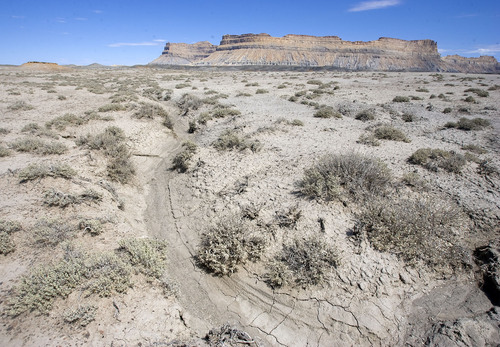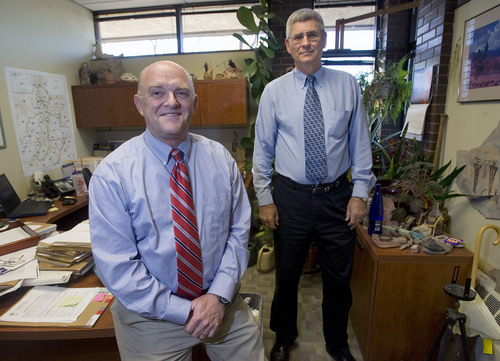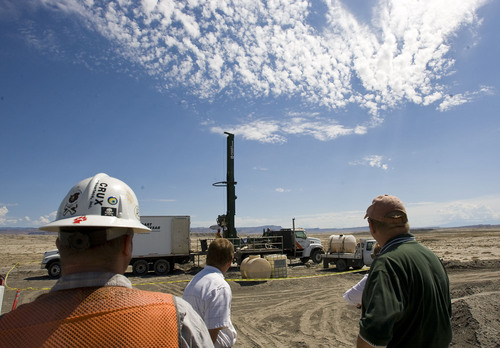This is an archived article that was published on sltrib.com in 2013, and information in the article may be outdated. It is provided only for personal research purposes and may not be reprinted.
The Utah state engineer was right to let a Provo-based company acquire Green River water to cool its proposed nuclear power reactor, a judge ruled Wednesday.
The decision by 7th District Judge George Harmond is the last major say any Utah official will have in the project proposed by Blue Castle Holdings.
From here on out, it's up to the Nuclear Regulatory Commission (NRC) — and the market — to decide whether the state's first commercial nuclear reactor will be built near Green River.
It would use up to 53,000 acre-feet of river water a year to cool its reactor, which would generate 3,000 megawatts of electricity.
The judge — like the state engineer before him — punted to the feds any judgment about the effect on the river and four endangered fish. The NRC will have to follow the National Environmental Policy Act (NEPA) process that assesses such environmental effects.
Harmond in September heard five days of testimony in the lawsuit brought by environmentalists and water users to block the transfer of water rights for the project.
Attorney Lara Swensen said an appeal by the environmental groups is possible. The judge's decision, she said, is no small matter.
"From the perspective of water … in Utah and the West, historically we place a great deal of scrutiny in tying up water in projects that may never happen," Swensen said.
Matt Pacenza, policy director for plaintiff Healthy Environment Alliance of Utah (HEAL Utah), said it seemed as if the judge "felt like he couldn't be the one to bury it."
Aaron Tilton, the former state representative who is president of Blue Castle, was happy but not surprised by the judge's ruling.
State Engineer Kent Jones spent two years carefully coming to his decision, Tilton said. "We thought the judge would support that original decision."
Two of the key questions before the judge were whether the project is economically feasible and whether Blue Castle has the financial ability to complete the project.
In both cases, Harmond noted that Utah water-rights case law has not established what economic feasibility and financial ability mean — especially in regard to such a large project.
Lacking such guidance, the judge set a low threshold on both, saying that Blue Castle doesn't have to prove its business plan will work or that it — or any future owner — will be able to raise the $15 billion to $20 billion needed to build the plant.
"It is far from certain that Blue Castle will find partners to construct the nuclear plant itself, but Blue Castle's business plan shows the project, if built, will eventually be profitable," Harmond wrote.
He said that while it's expensive to build a nuclear power plant, nuclear power is "ideal for baseline power, produces no carbon or particulate emissions and does not result in visual pollution."
Financing the project is possible, he wrote, noting that Blue Castle has raised $17.5 million of the cost for securing its early site permit from the NRC.
Tilton said the early site permit could cost $60 million, and an operating permit would cost another $40 million to secure. It will be 2017, at the earliest, before NRC decides whether to issue the early site permit, he said.
The former senator lauded the judge for acknowledging that Blue Castle, like many ventures involved in long-term projects, is working in stages.
"We have sufficient [money] for what we're doing now," he said. And while Blue Castle will have discussions with bigger partners that could take an equity stake, "We're not ready for that yet."
Swensen, the plaintiffs' attorney, said the judge's decision glossed over serious factual disputes between experts for the environmentalists and for Blue Castle, which were evident in five days of testimony.
The judge acknowledged differences of opinion between biologists on the effects on the river and fish, but said that will be studied under the NEPA process.
"This is a court saying there's a very, very low burden for Blue Castle to meet," Swensen said. "We feel there was inordinate deference given to [Blue Castle]."
Besides Blue Castle, defendants included Jones and the San Juan and Kane county water conservation districts. The later two had held the water rights at issue since they were originally awarded in the 1960s for coal-fired plants that were never built.
Besides HEAL Utah, plaintiffs included Living Rivers, Uranium Watch, Utah Rivers Council and local water users.
Twitter: @KristenMoulton







